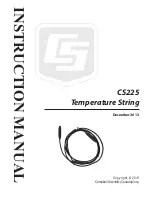
CS225 Temperature String
8
7.2 Reading the CS225
When power is supplied to the CS225 the internal electronics will continuously
measure temperature at a rate of approximately once per second. Every output
measurement (“aR0!” or “aM0!”) obtained from the sensor is a running
average of 10 consecutive readings. For this purpose after initial power up, a
delay of 10 seconds is recommended to obtain the best accuracy.
As the sensor is obtaining a measurement every second, it is recommended to
use the Continuous measurement command (aR0!) to obtain the temperature
readings. Using the “aR0!” commands will reduce the time taken in
comparison to the “aM0!” to obtain a reading via the SDI-12 protocol. The
lifetime and user resettable minimum and maximum temperature values are
single 1 second readings. For more details see Table 7-3.
The CS225 complies with a subset of the SDI-12 1.3 instruction set.
Specifically, it supports these SDI-12 commands:
a! acknowledge active of individual sensor
aI!, send identification
aR! (aR0! To aR7!), continuous measurements of the sensor. The R
command provides a faster means of obtaining the readings for sensors
that can provide continuous measurements. This instruction usually takes
less than 300 milliseconds to execute.
aM!, initiate measurement (and the subsequent aD0! “get data” command
which is automatically sent by a Campbell Scientific datalogger). This
instruction usually takes about 700 milliseconds to execute.
aAb!, change address a to b
Where in all cases “a” is the address of the sensor and “!” is the command
terminator. These two characters are normally sent implicitly by Campbell
Scientific dataloggers.
The CS225 output is measured using a standard SDI-12 instruction to read the
data from an SDI-12 sensor. For CRBasic dataloggers, the
SDI12Recorder()
instruction is used. For Campbell Scientific Edlog dataloggers, Instruction 105
is used. If using the sensor with other SDI-12 recorders, please refer to your
system’s documentation.
In any configuration of CS225 that includes more than one
sensor, the CS225 will not respond to the “?!” SDI-12 command
as each individual sensor will respond at the same time thus
disrupting all outputs. Use the “aI!” command in a trial & error
fashion if you need to determine the individual addresses of
temperature sensors.
NOTE
Summary of Contents for CS225
Page 2: ......







































